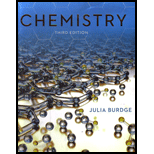
Concept explainers
A sample containing
Interpretation:
The mass percent of each compound in the sample is to be calculated.
Concept introduction:
The percent composition of an element by its mass in a compound can be calculated as:
Here, n represents the element’s number of atoms in the given molecule or compound.
The number of moles is defined as the ratio of mass to the molar mass.
Here,
Answer to Problem 133AP
Solution: The percent composition by mass of
Explanation of Solution
Given information: The percent composition by mass of
Let the mass of sample be
The mass of sodium is
The mass of oxygen is
The mass of chlorine is
The molar mass of sodium is
The molar mass of oxygen is
The molar mass of chlorine is
Calculate the number of moles of sodium as follows:
Substitute,
Calculate the number of moles of oxygen as follows:
Substitute,
Calculate the number of moles of chlorine as follows:
Substitute,
The element
The remaining value of
In
Equation (1) is as follows:
Equation (2) is as follows:
Multiply equation (1) by two and solve as follows:
Subtract equation (2) from equation (3) as follows:
The value of A can be calculated from value of B by using equation (1) as follows:
So, the number of moles of
The number of moles of
So, the number of moles of
The molar mass of
The molar mass of
The molar mass of
The mass of each compound in the sample can be calculated as:
Calculate the percent by mass of
Substitute,
Calculate the percent by mass of
Substitute,
Calculate the percent by mass of
Substitute,
Hence, the percent composition by mass of
Want to see more full solutions like this?
Chapter 3 Solutions
Chemistry
- 3.48 Calculate the mass in grams of 13.5 mol of (a) vinyl chlo- ride, C2H3Cl, the starting material for a plastic, (b) cap- saicin, C18H27NO3, the substance that makes red chili peppers "hot," and (c) stearic acid, C18H36O2 used in soaps.arrow_forwardEthylene glycol is used as an automobile antifreeze and in the manufacture of polyester fibers. The name glycol stems from the sweet taste of this poisonous compound. Combustion of 6.38 mg of ethylene glycol gives 9.06 mg CO2 and 5.58 mg H2O. The compound contains only C, H, and O. What are the mass percentages of the elements in ethylene glycol?arrow_forwardBoron forms an extensive series of compounds with hydrogen, all with the general formula BxHy. To analyze one of these compounds, you burn it in air and isolate the boron in the form of B2O3 and the hydrogen in the form of water. You find that 0.1482 g BxHy gives 0.4221 g B2O3 when burned in excess O2. Determine the empirical I formula of BxHy.arrow_forward
- The molecular formula of acetylsalicylic acid (aspirin), one of the most commonly used pain relievers, is C9H8O4. a. Calculate the molar mass of aspirin. b. A typical aspirin tablet contains 500. mg C9H8O4. What amount (moles) of C9H8O4 molecules and what number of molecules of acetylsalicylic acid are in a 500.-mg tablet?arrow_forwardCaffeine, the stimulant in coffee and tea, has the molecular formula C8H10N4O2. Calculate the mass percentage of each element in the substance. Give the answers to three significant figures.arrow_forwardA substance X2Z has the composition (by mass) of 40.0% X and 60.0% Z. What is the composition (by mass) of the compound XZ2?arrow_forward
- 3.113 MgCl2 is often found as an impurity in table salt (NaCl). If a 0.05200-g sample of table salt is found to contain 61.10% Cl by mass, describe how you could determine the percentage of MgCl2 in the sample.arrow_forwardYou have a pure sample of apholate, C12H24N9P3, a highly effective commercial insecticide. Calculate the molar mass of apholate. Calculate the mass of N in 100. g apholate. A sample containing 250.0 mg apholate is sprayed on an agricultural field. Calculate the mass of phosphorus in this sample of apholate; express your result in grams. Calculate the number of phosphorus atoms in this sample of apholate.arrow_forwardopical hydrocortisone is often used to treat a variety of skin conditions, such as insect bites, eczema, and rashes. Each molecule of hydrocortisone contains 21 atoms of carbon (plus other atoms). The mass percentage of carbon in hydrocortisone is 69.5 8%. What is the molar mass of hydrocortisone?arrow_forward
- 1. Express the composition of ammonium carbonate, (NH4)2CO3, in terms of the mass of each element in 1.00 mol of compound and the mass percent of each element. 2. What is the mass of carbon in 454 g octane, C8H18?arrow_forward3.96 Methyl cyanoacrylate is the chemical name for the substance sold as Super Glue, and it has the chemical formula C5H5NO2. Calculate the number of molecules of this substance in a 1.0-ounce tube of Super Glue, assuming that the glue is 80% methyl cyanoacrylate by mass.arrow_forwardA solution of scandium chloride was treated with silver nitrate. The chlorine in the scandium compound was converted to silver chloride, AgCl. A 58.9-mg sample of scandium chloride gave 167.4 mg of silver chloride. What are the mass percentages of Sc and Cl in scandium chloride? What is its empirical formula?arrow_forward
 Chemistry: An Atoms First ApproachChemistryISBN:9781305079243Author:Steven S. Zumdahl, Susan A. ZumdahlPublisher:Cengage Learning
Chemistry: An Atoms First ApproachChemistryISBN:9781305079243Author:Steven S. Zumdahl, Susan A. ZumdahlPublisher:Cengage Learning ChemistryChemistryISBN:9781305957404Author:Steven S. Zumdahl, Susan A. Zumdahl, Donald J. DeCostePublisher:Cengage Learning
ChemistryChemistryISBN:9781305957404Author:Steven S. Zumdahl, Susan A. Zumdahl, Donald J. DeCostePublisher:Cengage Learning
 Chemistry: The Molecular ScienceChemistryISBN:9781285199047Author:John W. Moore, Conrad L. StanitskiPublisher:Cengage Learning
Chemistry: The Molecular ScienceChemistryISBN:9781285199047Author:John W. Moore, Conrad L. StanitskiPublisher:Cengage Learning Chemistry & Chemical ReactivityChemistryISBN:9781337399074Author:John C. Kotz, Paul M. Treichel, John Townsend, David TreichelPublisher:Cengage Learning
Chemistry & Chemical ReactivityChemistryISBN:9781337399074Author:John C. Kotz, Paul M. Treichel, John Townsend, David TreichelPublisher:Cengage Learning Chemistry & Chemical ReactivityChemistryISBN:9781133949640Author:John C. Kotz, Paul M. Treichel, John Townsend, David TreichelPublisher:Cengage Learning
Chemistry & Chemical ReactivityChemistryISBN:9781133949640Author:John C. Kotz, Paul M. Treichel, John Townsend, David TreichelPublisher:Cengage Learning





